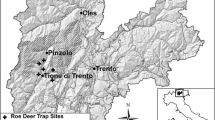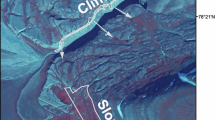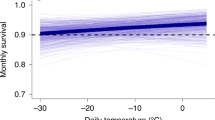Summary
When given a choice, animals often prefer foraging habitats where predation risk is low, even if such habitats provide reduced foraging opportunities. We evaluated foraging rates of tame but free-ranging Himalayan Snowcocks (Tetraogallus himalayensis) in 16 types of alpine habitats. Foraging rate was highest on level or slightly-sloping terrain and where grasses were relatively abundant. We also observed 102 wild snowcocks and found they were most nervous about raptorial predators when on level or slightly-sloping terrain and in small coveys. Snowcocks face a dilemma: they are most vulnerable to raptors in areas where they can forage most efficiently. During summer snowcocks trade off higher foraging efficiency on level terrain for lower predation risk on steeper terrain. During winter, when raptor numbers are lower, snowcocks apparently revert to using level or slightly-sloping, high-efficiency foraging habitats. Risk of predation plays an important role in habitat selection and resource utilization by snowcocks.
Similar content being viewed by others
References
Bertram BCR (1978) Living in groups: predators and prey. In: Krebs JR, Davies NB (eds) Behavioral Ecology: an evolutionary approach. Sinauer, Sunderland, MA, pp 64–96
Bland JD (1982) Patterns of summer habitat use by Himalaan Snowcocks in Nevada, USA. In: Savage CDW, Ridley MW (eds) Pheasants in Asia 1982. World Pheasant Assoc. Reading, England, pp 119–125
Bland JD, Temple SA (1987) Using hand-tamed birds in field studies. In: Bergquist CV (ed) Proc. 2nd Intnl Symp on Breeding Birds in Captivity. Intnl Found for Cons of Birds. Los Angeles, pp 1973–183
Bland JD, Temple SA (1990) America's newest bird: Himalayan Snowcocks. Am Birds (in press)
Caraco T, Martindale S, Pulliam HR (1980) Avian time budgets and distance to cover. Auk 97: 872–875
Cerri RD, Fraser DF (1983) Predation and risk in foraging minnows: balancing conflicting demands. Am Nat 121(4): 552–561
Dement'ev GP, Gladkov NA (1967) Birds of the Soviet Union, vol 12. Israel Program for Sci Transl, Jerusalem
Edwards J (1983) Diet shifts inmoose due to predator avoidance. Oecologia 60: 185–189
Fraser DF, Cerri RD (1982) Experimental evaluation of predatorprey relationships in a patchy environment: consequences for habitat use patterns in minnows. Ecology 63(2): 307–313
Grubb C, Greenwood L (1982) Sparrows and a brushpile: foraging responses to different combinations of predation risk and energy cost. Anim Behav 30: 637–640
Ives AR, Dobson AP (1987) Antipredator behavior and the population dynamics of simple predator-prey systems. Am Nat 130(3): 431–447
Kimmel RO, Healy WM (1987) Imprinting: a technique for wildlife research. In: Kimmel RO, Schulz JW, Mitchell GJ (eds) Perdix IV-Gray Partridge Workshop. Minn Dept Nat Res, Madelia, pp 39–52
Lazarus J (1979) The early warning function of flocking in birds: an experimental study with captive quelea. Anim Behav 27: 855–865
Lendrem DW (1983) Predation risk and vigilance in the blue tit (Parus caeruleus). Behav Ecol Sociobiol 14: 9–13
Lima SL (1985) Maximizing feeding efficiency and minimizing time exposed to predators: a trade-off in the black-capped chickadee. Oecologia 66: 60–67
Lima SL, Valone TJ, Caraco T (1985) Foraging-efficiency-predation-risk trade-off in the grey squirrel. Anim Behav 33: 155–165
Loope LL (1969) Subalpine and alpine vegetation of northeast Nevada. Ph.D. Thesis, Duke University. Durham, SC
Mayers J (1985) Studies of the ecology of Himalayan Snowcock (Tetraogallus himalayensis) in Hunza. World Pheasant Assoc J 10: 72–86
Neff DJ (1968) The pellet-group technique for big game trend, census, and distribution: a review. J Wildl Manage 32: 597–614
Powell GVN (1974) Experimental analysis of the social value of flocking by Starlings (Sturnus vulgaris) in relation to predation and foraging. Anim Behav 22: 501–505
Power ME (1984) Depth distributions of armored catfish: predator-induced resource avoidance? Ecology 65(2): 523–528
Smith DG, Murphy JR (1973) Breeding ecology of raptors in the eastern Great Basin of Utah. Brigham Young Univ Sci Bull Biol Ser 18
Stiver SJ (1984) The Himalayan Snowcock-Nevada's newest upland game. Trans. Cal-Neva Wildlife 26: 55–58
Thaler E (1986) Studies on the behavior of some Phasianidaechicks at the Alpenzoo-Innsbruck. In: Pheasants in Asia 1986. World Pheasant Assoc, Reading, England
Werner EE, Gilliam JF, Hall DJ, Mittelbach GG (1983) An experimental test of the effects of predation risk on habitat use in fish. Ecology 64(6): 1540–1548
Whittaker RH (1970) Communities and ecosystems. MacMillan, London
Author information
Authors and Affiliations
Rights and permissions
About this article
Cite this article
Bland, J.D., Temple, S.A. Effects of predation-risk on habitat use by Himalayan Snowcocks. Oecologia 82, 187–191 (1990). https://doi.org/10.1007/BF00323534
Received:
Accepted:
Issue Date:
DOI: https://doi.org/10.1007/BF00323534




